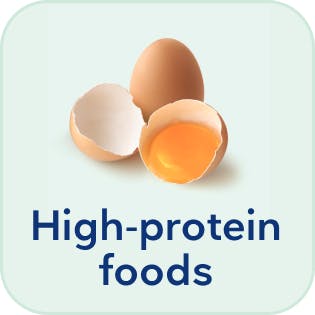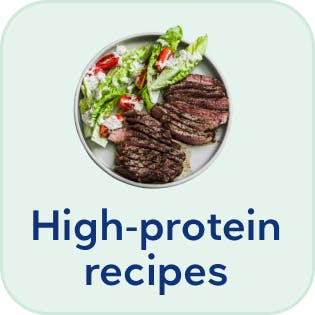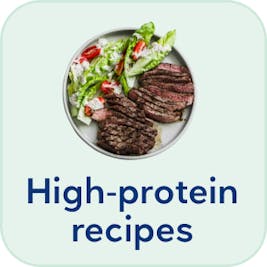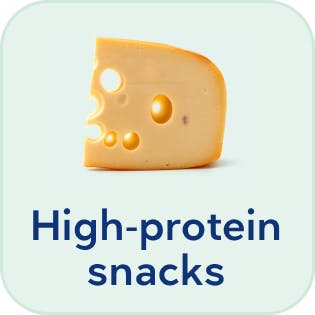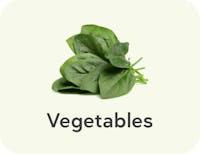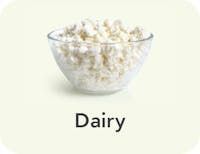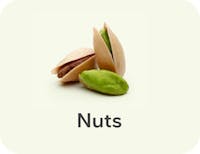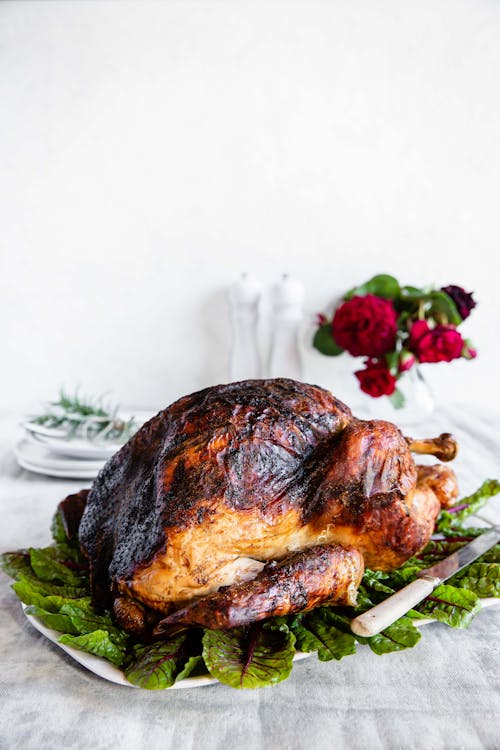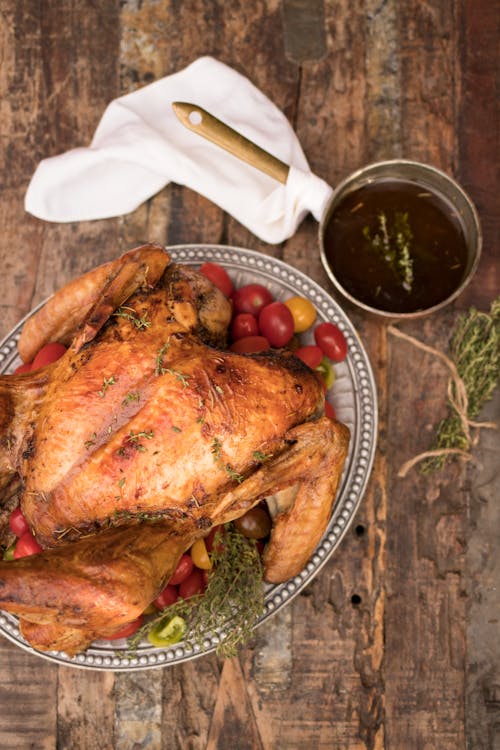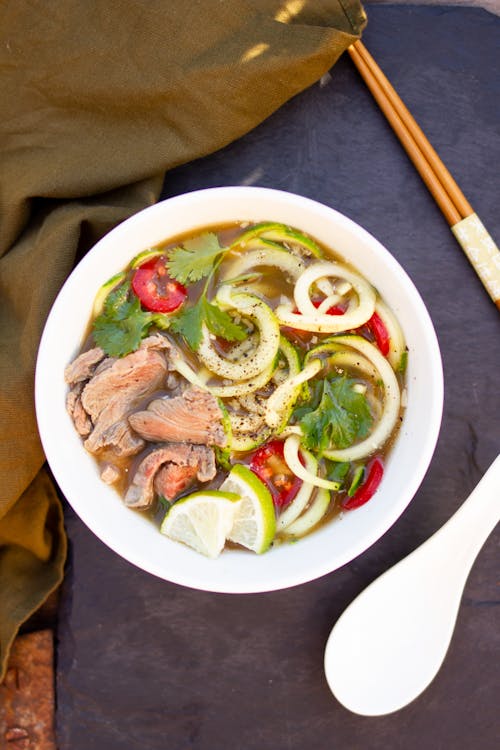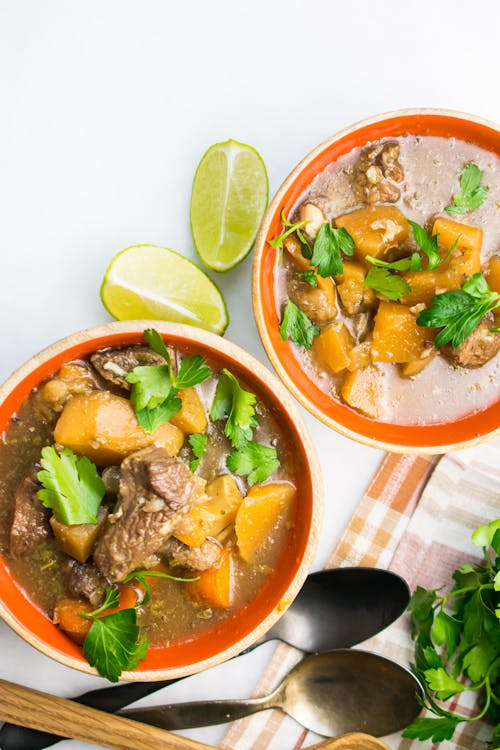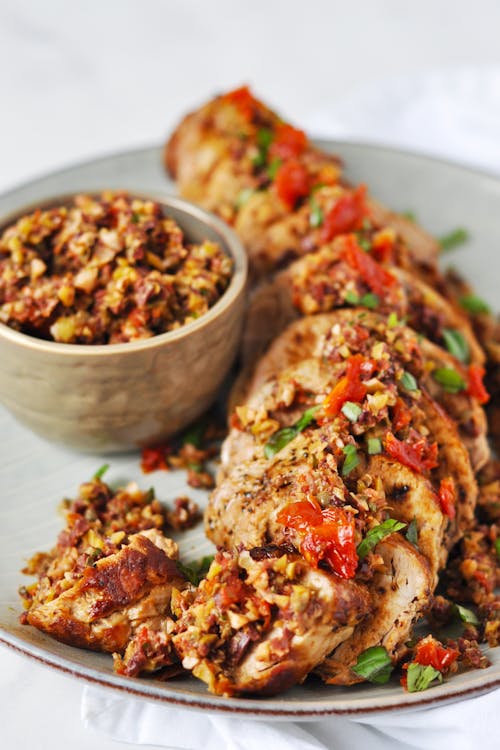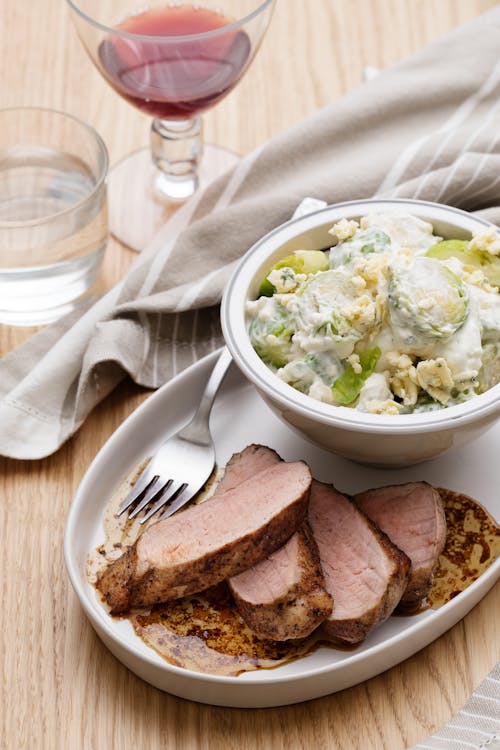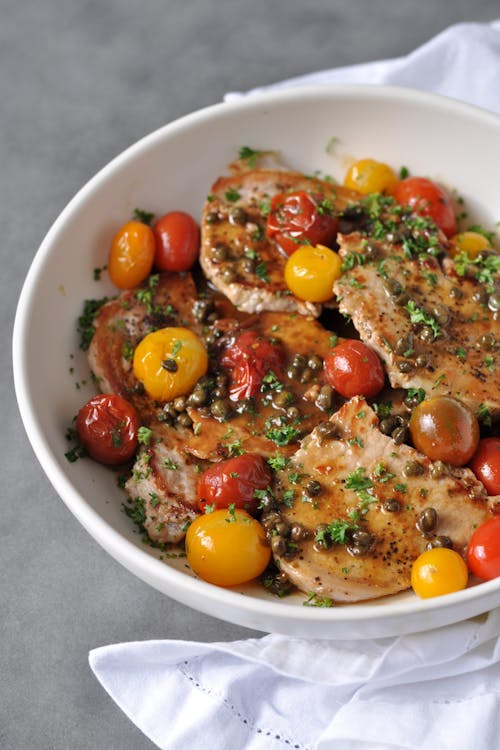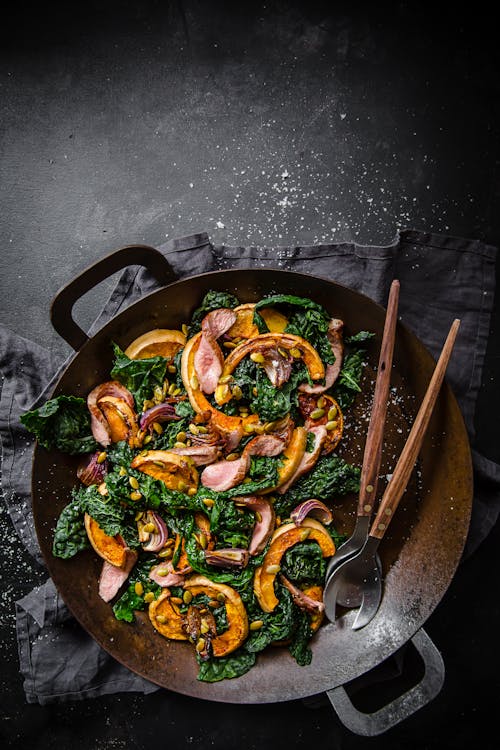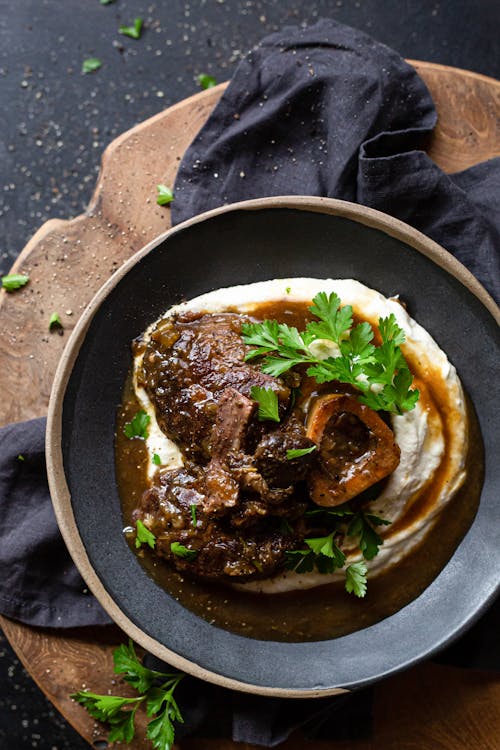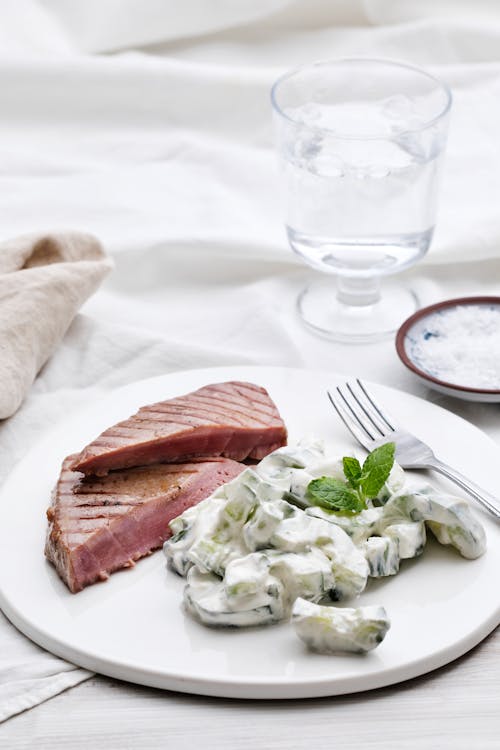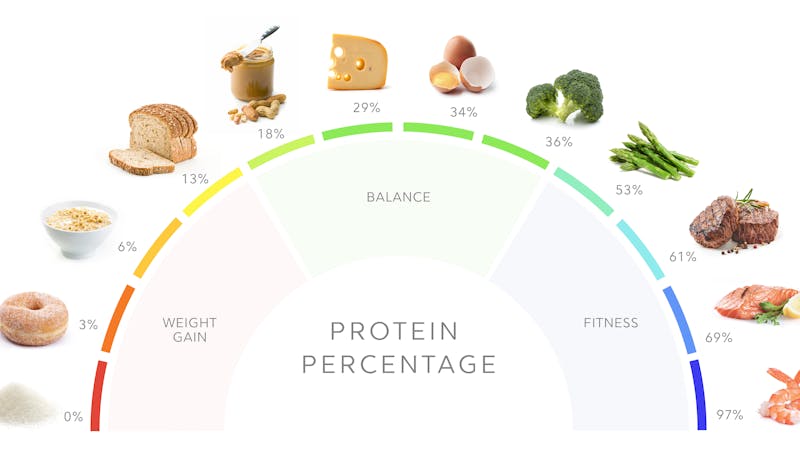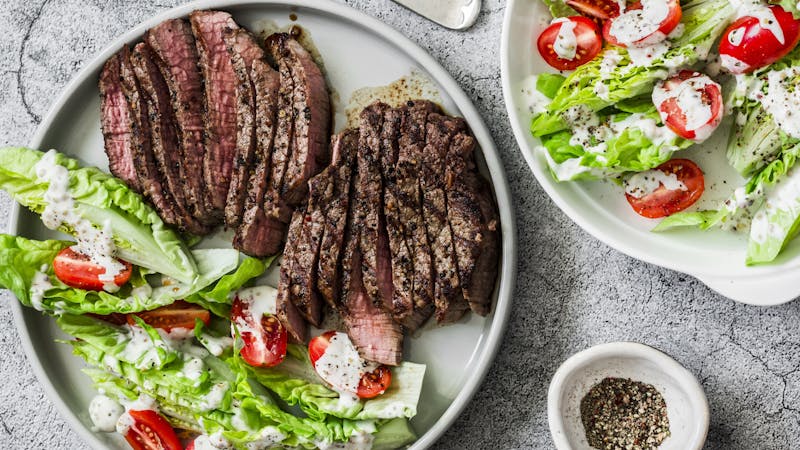The best high-protein meat, seafood & eggs
Meat, poultry, fish, shellfish, and eggs are high-protein foods that can help you lose weight. However, some types are better than others. The key? Maximizing satiety (feeling full and satisfied) per calorie when making food choices.
In this guide, we’ll show you how different types of meat, seafood, and eggs rate on the protein scale — and which ones to choose most often because they help you feel full and provide maximum nutrition value. Plus, we’ll share easy, tasty recipes based on these foods.
The image below shows the protein as a percentage of calories for different types of meat, seafood, and eggs.The higher the number, the more protein the food provides per calorie.
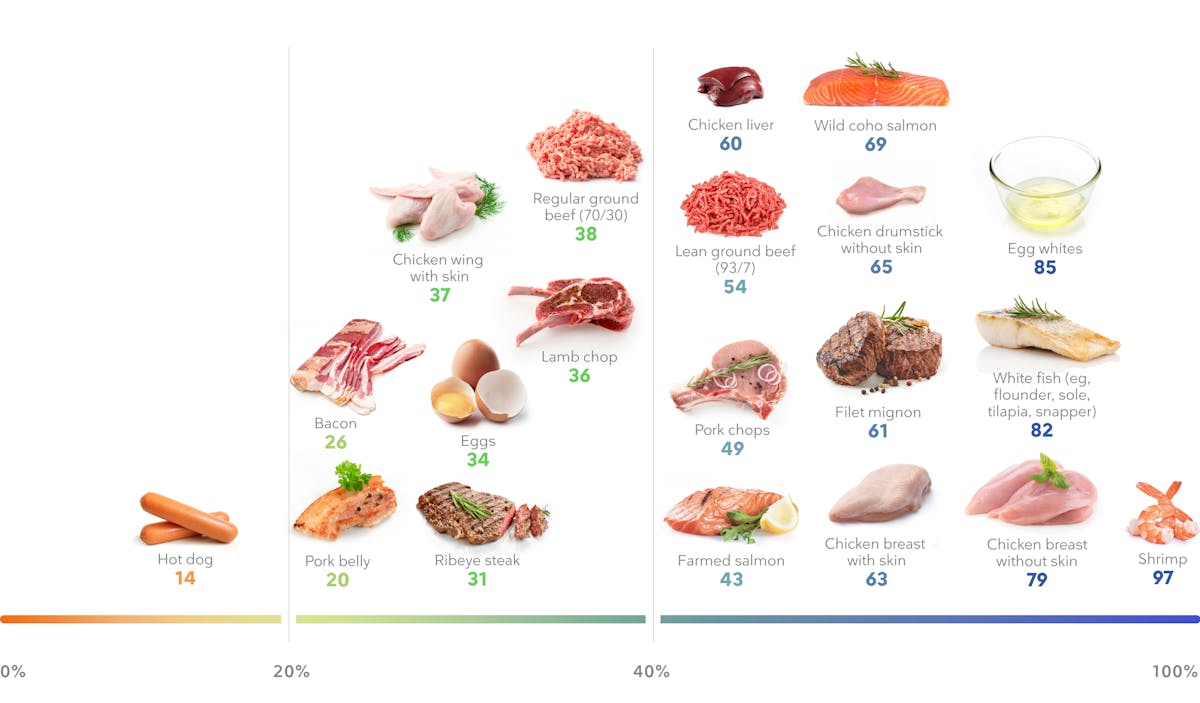


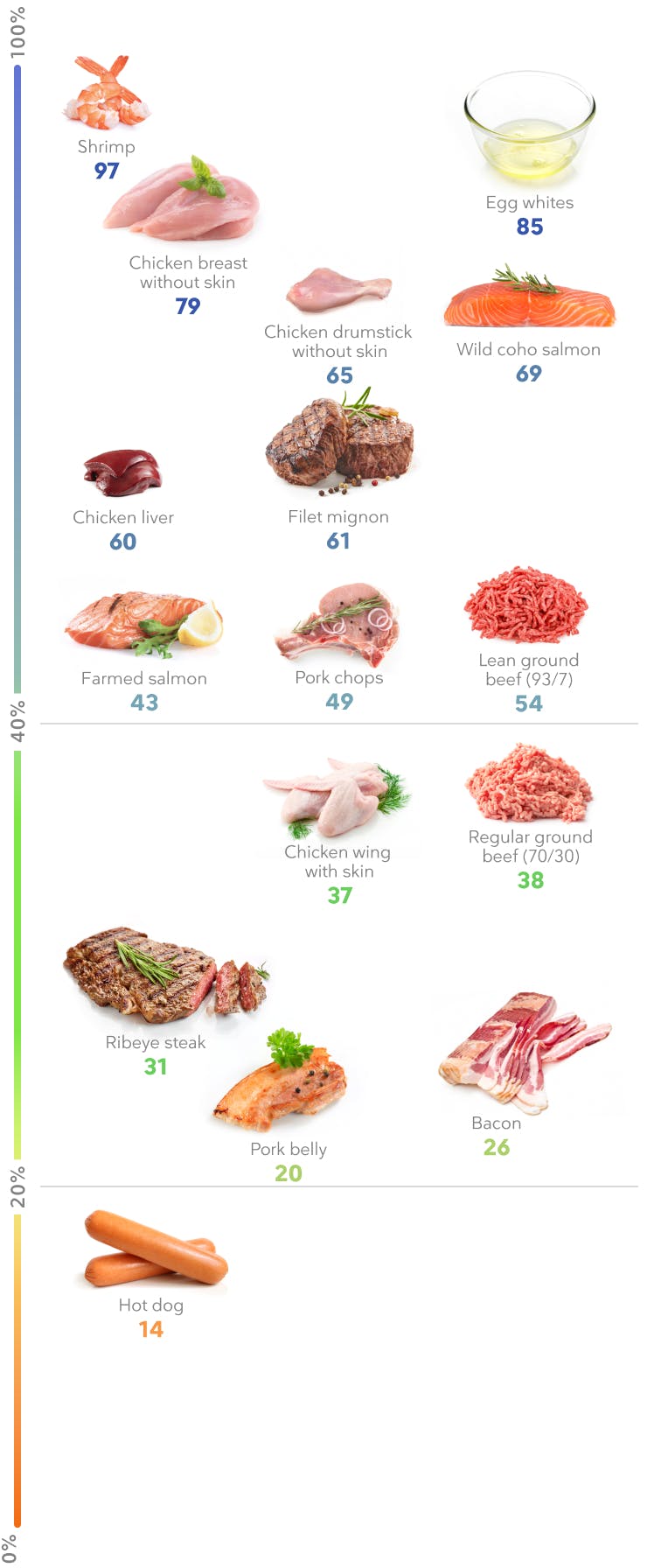


Key takeaways
Aim for a high protein percentage. To lose weight, eat protein-rich foods. Most of the time, try to choose meat and seafood with at least 35% of calories from protein. Learn moreBest red meat and poultry. Eat fresh meats like tenderloin, sirloin, lean ground meat, chicken, and turkey frequently. Eat processed meat less often. Learn more
Best fish and shellfish. Eat all types of fish, including salmon, trout, halibut, snapper, tuna, etc. Enjoy shrimp, crab, lobster, and most other shellfish, too. Learn more
More high-protein guides
More high-protein guides
Or watch a summary of this guide in video:
Focus on protein percentage
Strong evidence shows that eating more protein, and less fats and carbs, can help you lose weight by reducing appetite and keeping your metabolism from slowing down.1
To lose weight without feeling hungry, select protein-rich foods that provide the greatest satiety for the fewest calories.
How can you do this? By choosing foods with a high “protein percentage.” This percentage tells you how much of a food’s calories come from protein as opposed to fats and carbs.
We believe selecting meat and seafood with protein percentages of 35% or more most of the time can be very helpful for healthy weight loss. Generally speaking, leaner cuts of meat have higher protein percentages than fatty cuts do.
Additionally, aim to eat at least 100 grams of protein per day if you’re a woman and 140 grams if you’re a man of average height and build. Eat more if you’re a man taller than 6 feet (183 cm) or a woman taller than 5’6″ (168 cm) or if you’re very physically active. Eat less if you’re shorter or have a petite frame.
However, don’t feel that you need to meet all of your protein needs exclusively from the foods on this list. Dairy products, legumes, and vegetables can all contribute to your daily protein intake.
In this guide, we provide both the protein percentages and gram amounts per serving for meat, seafood, and eggs.2 These are based on average values. The protein percentages and gram amounts can vary depending on the cut of meat, the animal’s diet, the cooking method, and how much fat is trimmed before eating.
Note: The protein gram amounts are for cooked portions. Meat and seafood lose about 25% of their weight in cooking. The protein content of 4.5 ounces of raw meat or seafood is equivalent to about 3.5 ounces of cooked meat or seafood.
1. Poultry
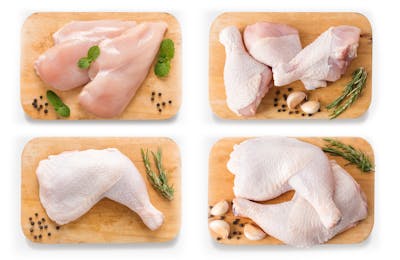



You’ll also get a nice dose of vitamins and minerals with that protein whether you choose light or dark meat.
The protein gram amounts reflect only the edible portion, not the bone. So whether you choose bone-in or boneless chicken breast or thighs, you’ll still get the same amount of protein.
Can you eat chicken with the skin and still lose weight? Yes. A piece of chicken with skin has a bit more fat and therefore a slightly lower protein percentage than the same piece without skin. However, you’ll still get about the same grams of protein per serving.3
Below are the protein percentages and grams of protein per 3.5-ounce (100-gram) serving of cooked poultry (about the size of a deck of cards).
Chicken
- Chicken breast without skin:
Protein percentage: 79%
30 to 32 grams of protein per serving (approximately half of a large chicken breast) - Chicken drumstick without skin:
Protein percentage: 65%
26 to 28 grams of protein per serving (approximately two medium drumsticks) - Chicken breast with skin:
Protein percentage: 63%
30 to 32 grams of protein per serving (approximately half of a large chicken breast) - Chicken liver:
Protein percentage: 60%
25 to 27 grams of protein and 1 gram of carbs per serving (limit liver to one serving per week due to its high vitamin A content) - Chicken wing without skin:
Protein percentage: 60%
30 to 32 grams of protein per serving (approximately five wings) - Chicken thigh without skin:
Protein percentage: 55%
24 to 26 grams of protein per serving (approximately one medium chicken thigh) - Chicken drumstick with skin:
Protein percentage: 52%
26 to 28 grams of protein per serving (approximately two medium drumsticks) - Ground chicken:
Protein percentage: 49%
22 to 24 grams of protein per serving - Chicken thigh with skin:
Protein percentage: 43%
24 to 26 grams of protein per serving (approximately one medium chicken thigh) - Chicken wing with skin:
Protein percentage: 37%
22 to 24 grams of protein per serving (approximately three wings)
Turkey
- Turkey breast without skin:
Protein percentage: 85%
30 to 32 grams of protein per serving - Turkey drumstick without skin:
Protein percentage: 67%
28 to 30 grams of protein per serving - Turkey breast with skin:
Protein percentage: 66%
30 to 32 grams of protein per serving - Turkey drumstick with skin:
Protein percentage: 57%
28 to 30 grams of protein per serving - Ground turkey (lean):
Protein percentage: 50%
25 to 27 grams of protein per serving - Ground turkey (regular):
Protein percentage: 42%
25 to 27 grams of protein per serving
High-protein poultry recipes
2. Red meat
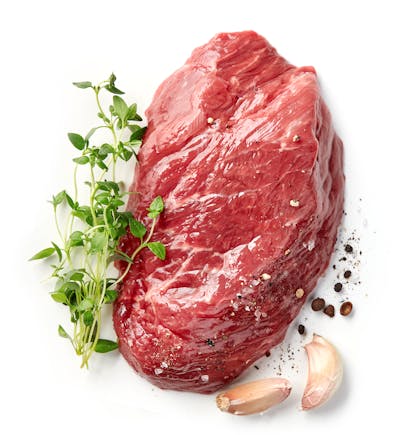



For example, 3.5 ounces (100 grams) of lean beef steak contains little fat, so its protein percentage is very high at 70%. By comparison, 3.5 ounces of beef brisket has about the same grams of protein as 3.5 ounces of lean steak, but more fat (and calories).
Beef brisket’s protein percentage is 40% because it provides much less protein per calorie than lean steak.
Choosing meats with protein percentages above 35% may help you lose weight most effectively. However, food enjoyment and variety are important, too! So feel free to eat your favorite meats that have lower protein percentages sometimes.
Here are the protein percentages and grams of protein per 3.5-ounce (100-gram) serving of cooked red meat (about the size of a deck of cards).
Beef
- Eye of round steak:
Protein percentage: 70%
28 to 30 grams of protein per serving - Top sirloin steak:
Protein percentage: 69%
28 to 30 grams of protein per serving - Liver:
Protein percentage: 62%
27 to 29 grams of protein and 4 grams of carbs per serving (limit liver to one serving per week due to its high vitamin A content) - Filet mignon (beef tenderloin):
Protein percentage: 61%
28 to 30 grams of protein per serving - Ground beef, lean (93% lean/7% fat):
Protein percentage: 54%
25 to 27 grams of protein per serving
- Ground beef, regular (85/15):
Protein percentage: 42%
24 to 26 grams of protein per serving - Brisket:
Protein percentage: 40%
27 to 29 grams of protein per serving - Ground beef, regular (70/30):
Protein percentage: 38%
24 to 26 grams of protein per serving - Ribeye steak:
Protein percentage: 31%
20 to 24 grams of protein per serving - Prime rib:
Protein percentage: 30%
20 to 24 grams of protein per serving
What do these fractions mean?
Ground beef classifications like extra-lean, lean, etc., are defined by laws set by the USDA. They are based on the percentage of lean and fat a meat contains by weight (which includes water) rather than the percentage of protein and fat that contribute to calories.You will often see 93/7 (lean), 85/15, and similar numbers on meat packages. Don’t let those values confuse you! Just focus on the protein percentages for different ground meats in this guide.
Pork
- Pork tenderloin:
Protein percentage: 71%
26 to 28 grams of protein per serving - Ground pork, extra-lean (94% lean/6% fat):
Protein percentage: 64%
28 to 30 grams of protein per serving - Pork chops:
Protein percentage: 49%
26 to 28 grams of protein per serving - Pork roast:
Protein percentage: 47%
26 to 28 grams of protein per serving - Ground pork, regular (85/15):
Protein percentage: 36%
26 to 28 grams of protein per serving - Pork shoulder:
Protein percentage: 34%
22 to 24 grams of protein per serving - Ground pork, regular (72/28):
Protein percentage: 25%
22 to 24 grams of protein per serving - Pork ribs:
Protein percentage: 23%
19 to 22 grams of protein per serving (three medium ribs) - Pork belly:
Protein percentage: 20%
15 to 18 grams of protein per serving
Lamb
- Lamb tenderloin:
Protein percentage: 67%
30 to 32 grams of protein per serving - Leg of lamb:
Protein percentage: 50%
26 to 28 grams of protein per serving - Lamb shank:
Protein percentage: 47%
28 to 30 grams of protein per serving - Lamb chops or rack of lamb:
Protein percentage: 36%
27 to 29 grams of protein per serving (approximately two to three lamb chops) - Ground lamb:
Protein percentage: 36%
24 to 26 grams of protein per serving
Bison
- Top round or ribeye steak:
Protein percentage: 70%
29 to 31 grams of protein per serving - Ground bison:
Protein percentage: 59%
25 to 27 grams of protein per serving
Veal
- Sirloin:
Protein percentage: 59%
25 to 27 grams of protein per serving - Ground veal:
Protein percentage: 56%
23 to 25 grams of protein per serving - Rib:
Protein percentage: 42%
23 to 25 grams of protein per serving
High-protein red meat recipes
3. Deli and prepared meats
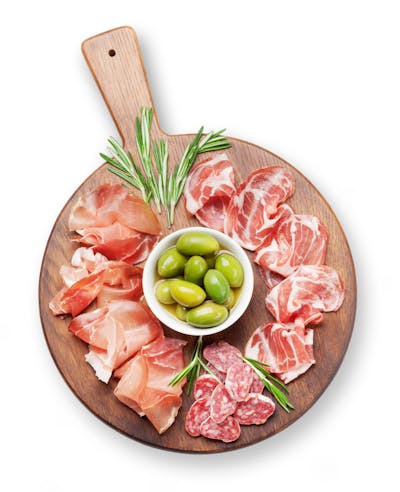



Although claims that they may lead to health problems are based on very weak observational evidence, processed meats generally contain less protein than fresh meat.4Therefore, most of them are not ideal for losing weight.
The good news is, some processed meats do have high protein percentages. Enjoy these regularly, and save some of the other types for when you want to occasionally indulge.
Here are the protein percentages and grams of protein per 3.5-ounce (100-gram) serving of deli and prepared meats (about the size of a deck of cards, unless otherwise noted).5
- Canadian bacon (extra-lean ham):
Protein percentage: 77%
27 to 29 grams of protein per serving - Lean turkey, chicken, roast beef, or ham deli meat:
Protein percentage: 60 to 80% (Extra-lean meat without added sugar or fillers may have protein percentages as high as 80%)
15 to 20 grams of protein per serving - Pastrami:
Protein percentage: 60%
20 to 24 grams of protein per serving (Read the label to find the number of slices per serving) - Prosciutto:
Protein percentage: 54%
20 to 24 grams of protein per serving (Read the label to find the number of slices per serving) - Chicken or turkey sausage:
Protein percentage: 46%
18 to 20 grams of protein per serving (approximately four to six medium links) - Turkey bacon:
Protein percentage: 45%
38 to 42 grams of protein per 3.5 ounces /100 grams (approximately eight slices)
19 to 21 grams of protein per serving (approximately four slices) - Corned beef:
Protein percentage: 43%
25 to 28 grams of protein per serving - Bacon:
Protein percentage: 26%
33 to 37 grams of protein per 3.5 ounces/100 grams (approximately 12 slices)
11 to 12 grams of protein per serving (approximately four slices) - Pork sausage:
Protein percentage: 22%
15 to 18 grams of protein (approximately four to six medium links) - Salami:
Protein percentage: 22%
18 to 22 grams of protein per 3.5 ounces/100 grams (approximately 10 medium slices)
9 to 11 grams of protein per serving (approximately five slices) - Liverwurst:
Protein percentage: 17%
14 to 16 grams of protein (approximately one-half cup) - Hot dog:
Protein percentage: 14%
10 to 12 grams of protein (approximately two medium-sized hot dogs)
4. Seafood
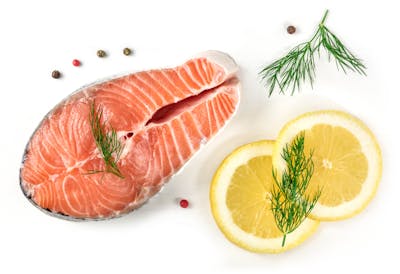



Make seafood choices based on your preferences and what is available. Canned fish and shellfish are convenient, less expensive options.
Enjoy seafood several times a week, if you like. However, avoid or limit types of fish that are high in mercury, especially larger fish like bigeye tuna, King mackerel, swordfish, and shark.
Fish
Besides packing plenty of protein, fish are rich in vitamin B2 (riboflavin), potassium, and selenium, among other nutrients. While fatty fish like salmon and sardines have slightly lower protein percentages than lean fish, they provide higher amounts of essential omega-3 fatty acids.
Here are the protein percentages and grams of protein per 3.5-ounce (100-gram) serving of cooked fish (about the size of a deck of cards), unless otherwise noted.
- White fish (such as flounder, sole, halibut, pollack, snapper, and tilapia):
Protein percentage: 82%
23 to 27 grams of protein per serving - Sea bass:
Protein percentage: 77%
24 to 26 grams of protein per serving - Canned tuna (light or albacore):
Protein percentage: 75%
23 to 25 grams of protein per serving (Limit to once a week due to its high mercury content) - Canned pink salmon*:
Protein percentage: 73%
24 to 26 grams of protein per serving - Wild salmon (Coho):
Protein percentage: 69%
23 to 25 grams of protein per serving - Raw tuna (sashimi):
Protein percentage: 64%
22 to 24 grams of protein per serving (Limit tuna to once a week due to its high mercury content) - Anchovies:
Protein percentage: 62%
24 to 26 grams of protein per serving - Trout:
Protein percentage: 57%
26 to 28 grams of protein per serving - Raw salmon (Atlantic):
Protein percentage: 56%
19 to 21 grams of protein per serving - Farmed salmon (Coho):
Protein percentage: 54%
23 to 25 grams of protein per serving - Herring:
Protein percentage: 46%
23 to 25 grams of protein per serving - Sardines:
Protein percentage: 45%
23 to 25 grams of protein per serving - Farmed salmon (Atlantic):
Protein percentage: 43%
21 to 23 grams of protein per serving - Mackerel:
Protein percentage: 38%
23 to 25 grams of protein per serving
*Note: Different species of salmon have different fat contents and therefore higher or lower protein percentages.
Shellfish
All shellfish are high in protein and low in fat. However, some contain a few carbs, which lowers their protein percentage. Shellfish are also a great source of vitamin B12, magnesium, and iodine.
Here are the protein percentages and grams of protein per 3.5-ounce (100-gram) serving of cooked shellfish, unless otherwise noted.
- Shrimp and prawns:
Protein percentage: 97%
23 to 25 grams of protein per serving (10 to 12 medium shrimp or prawns) - Crab:
Protein percentage: 87%
18 to 20 grams of protein per serving (approximately one average crab leg or one cup of cooked crab) - Lobster:
Protein percentage: 85%
20 to 22 grams of protein per serving (approximately one small lobster tail or two-thirds of a cup of cooked lobster) - Scallops:
Protein percentage: 76%
18 to 20 grams of protein and 4 to 5 grams of carbs per serving (six large sea scallops) - Octopus:
Protein percentage: 73%
26 to 28 grams of protein and 4 to 5 grams of carbs per serving (approximately one-half cup) - Clams:
Protein percentage: 70%
24 to 26 grams of protein and 5 grams of carbs per serving (approximately 10 small clams) - Squid:
Protein percentage: 69%
17 to 19 grams of protein and 3 grams of carbs per serving (approximately one-half cup) - Mussels:
Protein percentage: 56%
24 grams of protein and 7 grams of carbs per serving (approximately 20 to 25 medium mussels) - Oysters (raw):
Protein percentage: 49%
5 to 10 grams of protein and 5 to 6 grams carbs per serving (approximately four to eight medium oysters, depending on the type) 6 - Oysters (cooked):
Protein percentage: 47%
12 to 19 grams of protein and 6 to 8 grams of carbs per serving (approximately 10 to 12 medium oysters, depending on the type) 7
High-protein fish and shellfish recipes
5. Eggs
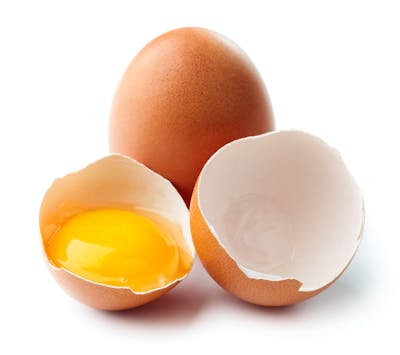



Egg whites provide more protein per calorie than egg yolks. However, the yolks contain more essential nutrients, such as vitamin A and selenium, than egg whites. Whole eggs are more nutritious overall and taste better than egg whites.
We recommend that you mainly eat whole eggs, but feel free to also include some egg whites if you find it hard to meet your protein targets.
Here are the protein percentages and grams of protein per 3.5-ounce (100-gram) serving of eggs:
- Egg whites:
Protein percentage: 85%
11 grams of protein per serving (three large egg whites) - Whole eggs:
Protein percentage: 34%
12 grams of protein per serving (two large eggs) - Egg yolks:
Protein percentage: 20%
16 grams of protein per serving (six large egg yolks)
Start your FREE 7-day trial!
Get instant access to healthy low-carb and keto meal plans, fast and easy recipes, weight loss advice from medical experts, and so much more. A healthier life starts now with your free trial!
Start FREE trial!Learn more about protein
The best high-protein meat, seafood & eggs - the evidence
This guide is written by Franziska Spritzler, RD and was last updated on June 19, 2025. It was medically reviewed by Dr. Bret Scher, MD on May 14, 2021.
The guide contains scientific references. You can find these in the notes throughout the text, and click the links to read the peer-reviewed scientific papers. When appropriate we include a grading of the strength of the evidence, with a link to our policy on this. Our evidence-based guides are updated at least once per year to reflect and reference the latest science on the topic.
All our evidence-based health guides are written or reviewed by medical doctors who are experts on the topic. To stay unbiased we show no ads, sell no physical products, and take no money from the industry. We're fully funded by the people, via an optional membership. Most information at Diet Doctor is free forever.
Read more about our policies and work with evidence-based guides, nutritional controversies, our editorial team, and our medical review board.
Should you find any inaccuracy in this guide, please email andreas@dietdoctor.com.
Systematic reviews of randomized controlled trials — considered the strongest type of evidence — demonstrate that higher-protein diets tend to help people feel full, lose weight, and maintain a higher metabolic rate:
Journal of the American College of Nutrition 2004: The effects of high protein diets on thermogenesis, satiety and weight loss: a critical review [systematic review of randomized trials; strong evidence]
Nutrition Reviews 2016: Effects of dietary protein intake on body composition changes after weight loss in older adults: a systematic review and meta-analysis [systematic review of randomized trials; strong evidence]
The American Journal of Clinical Nutrition 2012: Effects of energy-restricted high-protein, low-fat compared with standard-protein, low-fat diets: a meta-analysis of randomized controlled trials [systematic review of randomized trials; strong evidence] ↩
We obtained nutrition information from FoodData Central, the USDA’s nutrient profile database. ↩
Chicken wings are different, as they have a lot of skin and not that much meat. Therefore, a 3.5-ounce/100-gram serving of wing meat is approximately five wings without skin but only about three wings with skin. Five wings without skin provide more protein and less fat than three wings with skin. However, even chicken wings with the skin on still contain more than 35% protein ↩
There are some exceptions, however. You can read the labels to see how much protein one serving provides. ↩
In some cases, 3.5 ounces as a serving size may be unrealistic, such as 12 slices of bacon. For these items, we also provide the amount of protein in a typical serving. ↩
Protein content varies widely among different oyster species ↩
Protein content varies widely among different oyster species ↩



